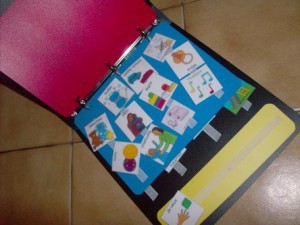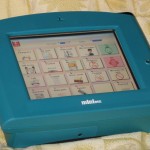PECS

Picture Exchange Communication System, referred to as PECS, is a system of visuals designed and proven to teach children who cannot speak how to communicate through pictures and eventually how to vocally communicate with others. In addition to selecting a desired picture, the child is taught to verbally say what he wants as well, as he is selecting the picture.
PHASE I
Children learn to exchange just one picture to receive an item or activity they want. For example, your child may really like cheerios. You take a picture of the Cheerios box and then whenever he wants Cheerios, you have him give you the picture first. This creates the contingency of using pictures to communicate what he wants.
PHASE II
The child will still be using single pictures, but now she will learn how to generalize this skill across people and places. For example, bring the pictures to the store with you and have her communicate with you in that setting. In addition, have the child’s school, her grandparents, etc. use PECS with her. If you only use PECS at home with just mom and dad, it is possible the skill will not generalize to others or to other places.
PHASE III
Here the child will learn to select from two or more pictures to ask for something. Typically the child will have a PECS book, which is filled with pictures (choices) that they can choose from, which are attached with Velcro so they can be pulled off and reattached easily many times.
PHASE IV
In this phase, the child will learn how to structure a simple sentence using the pictures. They will do this by placing pictures on a detachable sentence strip using an “I want” picture followed by a picture of the item being requested.
Children can then learn to expand their sentences by adding adjectives, verbs and prepositions.
PHASE V
Children will then learn to use PECS to answer the question, “What do you want?” Remember, use this as consistently as possible and it will work quickly.
PHASE VI
The last phase is a continuation of Phase V. Here, children learn to respond to other questions such as, “What do you see?”, “What do you hear?” and “What is it?” Instead of just using the “I want” picture, they can create sentences using “I see”, “I hear”, “I feel”, “It is a”, etc.
Augmentative Communication Devices

Another popular communication aid is an electronic augmentative communication device. These often resemble an electronic version of the PECS system, however when you chose a picture, the device will speak in a synthesized voice so the child does not have to. In addition to having pictures to choose from, these devices will often include a keyboard where the child can type words out and have the computer speak them.
These devices can be great for some children, but can delay others. Children who have severe speech impediments, physical impairments where they may be unable to physically speak, or if they need a device to track eye movements to speak, etc.; these devices can open up a whole new world of communicating with anyone. However, if these devices are used with a child who does not NEED this type of communication aid, it may inhibit the development of her own speech since they never have to emit actual words themselves.
Check out these other blog posts about language and communication:

